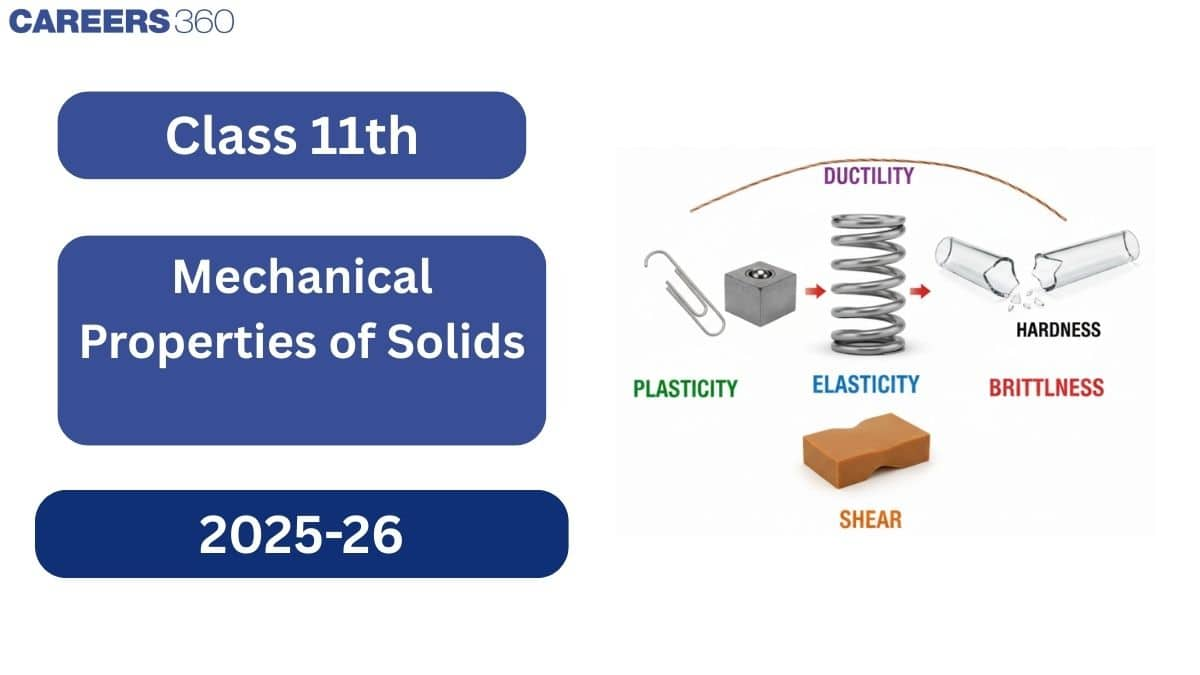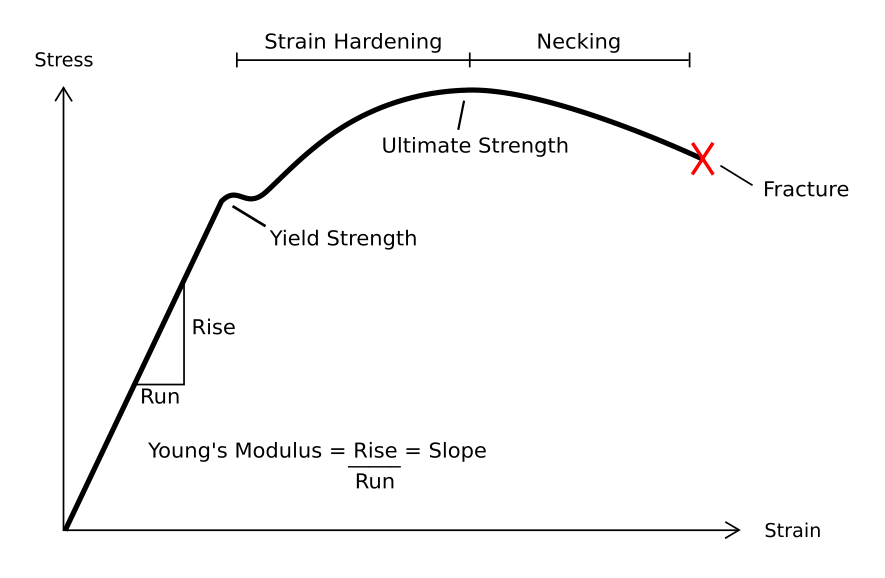Mechanical Properties of Solids
If all of the atoms in a substance are closely packed together, it is considered to be in the solid state. The shape and dimensions of solid material are fixed. An external force must be applied to modify the shape and size of the solid item. The Mechanical Properties of Solids will be covered in this chapter.

Solids' mechanical properties define properties such as strength and deformation resistance. It represents an object's ability to endure the stress that is applied to it. Elasticity, plasticity, strength, abrasion, hardness, ductility, brittleness, malleability, and toughness are examples of mechanical qualities. There are some notable properties and the laws governing this chapter 9 of the NCERT textbook for class 11 Physics, Mechanical Properties of Solids.
Mechanical Properties of Solids Class 11th Topics (NCERT Syllabus)
1. Introduction
Solids have definite shape and size, but they can be stretched, compressed, or bent when force is applied. The property of regaining original shape after deformation is called elasticity, while permanent deformation is called plasticity. Understanding elastic behavior of materials is important in designing buildings, bridges, vehicles, and many other structures.
2. Stress and Strain
Stress:
If a body is distorted as a result of an external force, an internal force is produced at each and every section of the body that attempts to restore the body to its original state. Stress is the name for this internal energy.
Stress $=$ F/A its unit is $\mathrm{N} / \mathrm{m}^2$ or Pascal.
Types of stress:
There are three types of stress:
(a) Longitudinal Stress: Longitudinal Stress occurs when the deforming force of a cylindrical body is applied normally to the area of cross-section. A change in the length of an object occurs when it is subjected to longitudinal stress.
There are two forms of longitudinal stress.-
Tensile force: Tensile stress is defined as an increase in the length of an object as a result of the applied force effect.
Compressional stress occurs when the length of an object decreases as a result of the applied force effect.
(b) Shearing or Tangential Stress: Tangential stress is defined as the restoring force per unit area when the applied force is parallel to the body's cross-sectional area. When applied tangentially, the deforming force causes changes in the shape of the body.
(c) Hydraulic Stress: Hydraulic stress refers to the restoring force that a fluid like water exerts per unit area on a body or item.
Strain:
Strain is defined as a change in the size and shape of a body caused by the application of a deforming force. Strain is defined as the proportion of a change in shape or size to the initial shape or size. It is nothing more than a number with no dimensions.
There are three different sorts of strains:
Shearing strain is the measurement of the relative displacement on opposite faces of the body caused by shearing stress.
(b) Longitudinal strain: The original length of the body changes as a result of the imposed longitudinal stress. Longitudinal strain is defined as the difference between the current length and the original length
(c) Strain of volume:
The strain produced by a hydraulic pressure is called volume strain and is defined as the ratio of change in volume ( $\Delta V$ ) to the original volume ( $V$ ).
$
\text { Volume strain }=\frac{\Delta V}{V}
$
3. Hooke's Law
Within the elastic limit, the deformation (strain) of a body is directly proportional to the applied stress.
$
\text { Stress } \propto \text { Strain }
$
or
$
\text { Stress }=E \times \text { Strain }
$
where $E$ is the modulus of elasticity.
4. Stress-Strain Curve
A line created by stress and strain is known as the stress-strain curve. A stress-strain curve for a material gives the relationship between stress and strain in the ideal case of Hooke's law. It's calculated by progressively adding load to a test coupon and measuring deformation, from which stress and strain may be calculated (see tensile testing). Many properties of a material are revealed by these curves, including Young's modulus, yield strength, and ultimate tensile strength.

Strain
Strain is the amount of deformation experienced by the body in the direction of force applied, divided by the initial dimensions of the body.
$E=\delta / L$
is the change in length and L is the original length of the material.
The strain is a dimensionless quantity as it just defines the relative change in shape.
5. Elastic Moduli:
The ratio of strain and stress is known as the modulus of elasticity, or Elastic Moduli. It is one of the material's most fundamental features. Young's modulus, Shear modulus, and Bulk modulus are the three forms of elastic moduli.
Young's Rigidity Modulus:
Within the elastic limit, Young's Modulus of Rigidity is defined as the ratio of longitudinal stress to longitudinal strain. Young's Modulus is represented by the letter Y. Metals have high Young Modulus values when compared to other materials.
Y = Normal Stress / Longitudinal Strain
Bulk Modulus of Rigidity:
The ratio of normal stress to volumetric strain within the elastic limit is known as the Bulk Modulus of Rigidity. It is represented by B.
B = Normal Stress / Volumetric Strain
Shear Modulus ( $\eta$ )
Shear modulus is defined as the ratio of shearing stress to shearing strain.
$
\eta=\frac{\text { Shearing Stress }}{\text { Shearing Strain }}
$
If a tangential force $F$ is applied on the surface of a body of area $A$, producing a displacement $x$ in a layer of thickness $L$ :
$
\eta=\frac{F / A}{x / L}=\frac{F L}{A x}
$
Elastic Potential Energy in a Stretched Wire
When a wire of length $L$ and cross-sectional area $A$ is stretched by a force $F$ producing an elongation $\Delta L$, it stores energy due to deformation.
Work done by the force is stored as elastic potential energy (U):
$
U=\frac{1}{2} F \Delta L
$
Poisson's Ratio ( $\sigma$ )
When a wire or rod is stretched, it contracts laterally (perpendicular to the applied force) while elongating longitudinally.
Poisson's ratio is the ratio of lateral strain to longitudinal strain:
$
\sigma=\frac{\text { Lateral Strain }}{\text { Longitudinal Strain }}
$
Real-Life Examples of Mechanical Properties of Solids
Solids exhibit different mechanical properties that are widely used in daily life and engineering:
1. Elasticity: Solids regain their shape after removing the force.
Example: Springs in weighing scales, vehicles, and mattresses.
2. Plasticity: Solids retain deformation after force is removed.
Example: Modeling clay, putty, metal sheets in shaping industries.
3. Tensile Strength: Ability to resist stretching forces.
Example: Steel wires in bridges and suspension cables.
4. Shear Strength: Ability to resist sliding forces.
Example: Scissors, cutting tools, and bolts in machines.
Mechanical Properties of Solids - Important Formulas
1. Stress and Strain
Stress:
$
\text { Stress }=\frac{\text { Force }}{\text { Area }}=\frac{F}{A}
$
Strain:
$
\text { Strain }=\frac{\text { Change in Length }}{\text { Original Length }}=\frac{\Delta L}{L}
$
2. Hooke's Law
$
\text { Stress }=E \times \text { Strain } \Rightarrow E=\frac{\text { Stress }}{\text { Strain }}
$
$E=$ Young's modulus
3. Elastic Moduli
Young's Modulus (E):
$
E=\frac{F L}{A \Delta L}
$
Shear Modulus ( $\boldsymbol{\eta}$ ):
$
\eta=\frac{\text { Shearing Stress }}{\text { Shearing Strain }}=\frac{F L}{A x}
$
Bulk Modulus (K):
$
K=\frac{\text { Hydrostatic Pressure }}{\text { Volumetric Strain }}=-\frac{\Delta P}{\Delta V / V}
$
4. Poisson's Ratio ( $\sigma$ )
$
\sigma=\frac{\text { Lateral Strain }}{\text { Longitudinal Strain }}
$
Relation between moduli:
$
E=2 \eta(1+\sigma), \quad K=\frac{E}{3(1-2 \sigma)}
$
5. Elastic Potential Energy (U)
$
U=\frac{1}{2} F \Delta L=\frac{1}{2} \frac{F^2 L}{A E}=\frac{1}{2} E \frac{A}{L}(\Delta L)^2
$
Exam Wise Weightage: Mechanical Properties of Solids
| Exam | Weightage | Remarks |
|---|---|---|
| JEE Main | Usually 1–2 questions | Topics like Hooke’s law, stress-strain, elastic moduli, and energy are common. |
| JEE Advanced | 1 Question | Often numerical or conceptual (e.g., stress-strain curves, Poisson’s ratio, energy stored). |
| NEET (Physics) | 1 Question | Mostly formula-based or simple conceptual (e.g., elasticity, deformation). |
NCERT Notes Subject Wise Link:
- NCERT notes Class 11 Maths
- NCERT notes Class 11 Physics
- NCERT notes Class 11 Chemistry
- NCERT notes Class 11 Biology
Importance of Mechanical Properties of Solids class 11:
All applicants preparing for entrance examinations such as JEE and NEET will benefit from the ncert solutions for class 11 physics chapter 9. Mechanical properties of solids notes, are particularly useful for revision when you are short on time and have a lot of material to cover. Every year, they have posted at least two questions from properties of solids and liquids, as has been the case over the past five years. This is one of the most important chapters on the syllabus. So, if you have enough time, tackle solids before fluids because solids introduce us to new concepts such as stress, strain, potential energy, and strain relation. These subjects aren't as important in fluids, but you should start with solids since if you miss a chapter in the middle, you'll end up with a backlog. one must practice all mechanical properties of solids neet questions and furthermore, one should also practice with mechanical properties of solids class 11 questions and answers pdf. Also to prepare the best one must refer to ncert solutions for class 11 physics chapter 9 and class 11 mechanical properties of solids notes combined.
If you have time constraints, then also you should do solids first as it is a small chapter which will not take much time of yours!
NCERT Solutions Subject wise link:
Frequently Asked Questions (FAQs)
A cylinder's twisting produces pure shear.
It's a substance that can be stretched elastically to huge strain values t.
It is defined as the ratio of the highest load applied to the wire to its original cross-sectional area.
The answer is zero.
This happens when the body is deformed beyond the elastic limit.